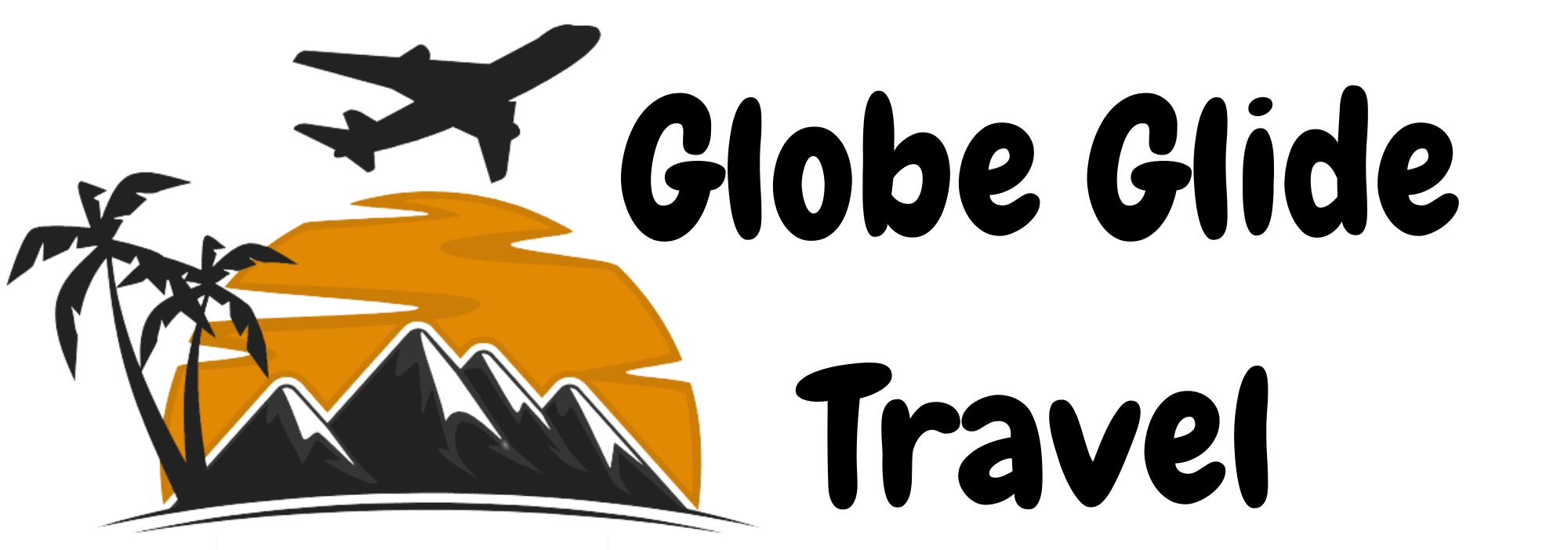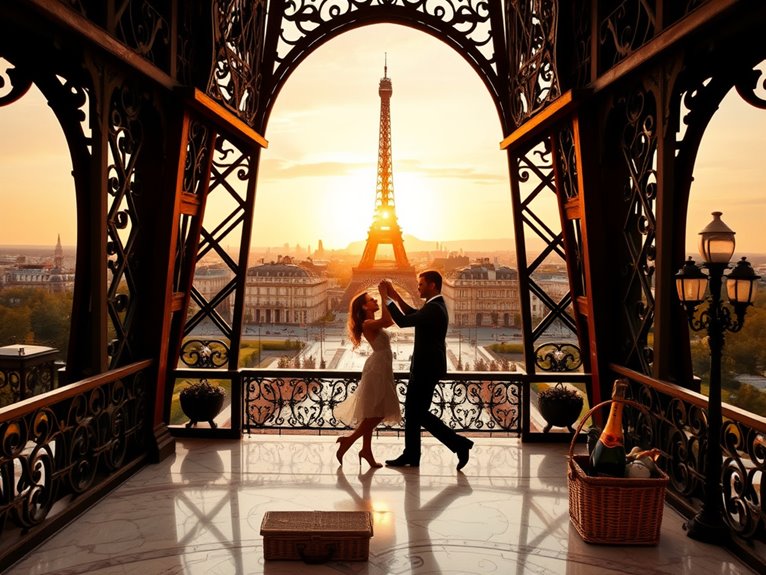
8 Iconic Movie Locations in Paris You Can Visit
I've found eight must-visit Paris movie locations that'll transport you into your favorite films! Start at Shakespeare and Company bookstore from "Midnight in Paris," then explore the mysterious Louvre from "The Da Vinci Code." Don't miss Amélie's charming Café des Deux Moulins in Montmartre, the romantic Pont des Arts, action-packed Arc de Triomphe, dreamy Luxembourg Gardens, and of course, the iconic Eiffel Tower. But there's one more special spot waiting to be discovered…
Shakespeare and Company Bookstore: A Literary Haven on Screen
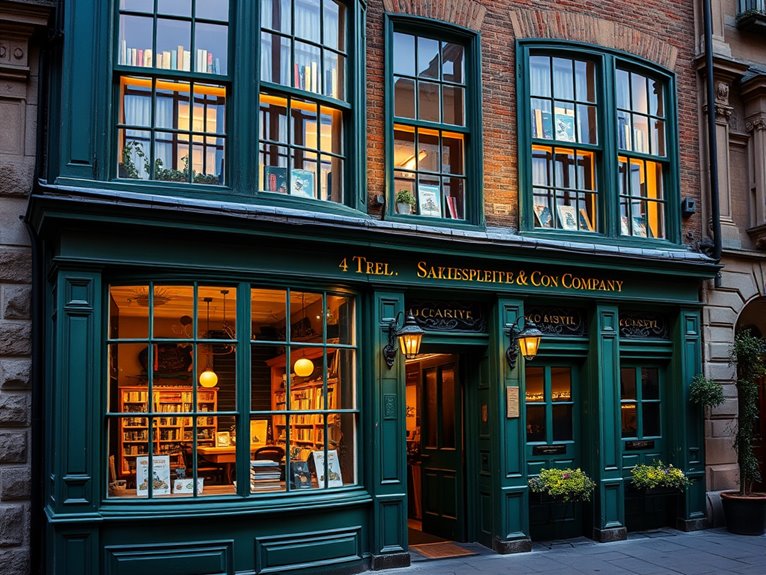
The bookstore's cinematic appeal lies in its perfectly preserved old-world charm and rich literary history. Founded in 1951 by George Whitman, this incarnation of Shakespeare and Company carries on the legacy of Sylvia Beach's original 1919 establishment, which served as a gathering place for literary giants like Ernest Hemingway and James Joyce. Today, it continues to draw both book lovers and film enthusiasts who seek to experience its unique atmosphere and perhaps catch a glimpse of where their favorite movie scenes were filmed.
Quick Facts:
- Opening Hours: 10:00 AM – 10:00 PM daily
- Photography: Exterior photos permitted; interior photos require permission
- Best Visiting Times: Early morning or during weekday afternoons
- Cost: Free entry
- Location: 37 Rue de la Bûcherie, 75005 Paris
- Nearest Metro: Saint-Michel Notre-Dame
- Special Features: Café adjacent to store, regular literary events
- Payment Methods: Cash and credit cards accepted
The Ground Floor
The main floor of Shakespeare and Company is where most iconic movie scenes are filmed. This cramped, cozy space features floor-to-ceiling wooden shelves stocked with new books, reading nooks, and the famous reading chair where Owen Wilson sat in "Midnight in Paris." The narrow aisles and vintage cash register create an authentically bohemian atmosphere that's irresistible to cinematographers.
The Upper Floor
Less frequently filmed but equally enchanting, the upper floor houses the reading library and sleeping quarters for "Tumbleweeds" – traveling writers who stay at the bookstore in exchange for helping out. This area features rare and secondhand books, complete with reading chairs by windows overlooking Notre-Dame Cathedral. Insider tip: Visit on Monday afternoons when weekly poetry readings are held here.
The Café
Added in 2015, the adjacent café isn't featured in older films but has become a destination in its own right. Serving organic coffee and vegetarian fare, it offers outdoor seating with a prime view of Notre-Dame. The café's vintage typewriter and literary-themed menu items make it a perfect spot for creating your own movie-worthy moments.
Pro Tips:
For the best photography opportunities, arrive just as the store opens at 10:00 AM when morning light hits the facade perfectly and before crowds gather. Film enthusiasts should visit during shoulder season (March-April or September-October) when tourist numbers are lower, making it easier to recreate famous movie scenes. Consider purchasing a book and having it stamped with the store's iconic logo – a service offered only to customers who buy in-store.
Practical Advice:
While the bookstore welcomes visitors, it's important to remember it's a functioning bookshop, not just a tourist attraction. Space is limited, so avoid bringing large bags or backpacks. If planning to photograph the interior, ask permission at the front desk and be mindful of other visitors. For the best experience, combine your visit with a walking tour of the Latin Quarter, as many other famous movie locations are within walking distance.
The Louvre: From The Da Vinci Code to Wonder Woman
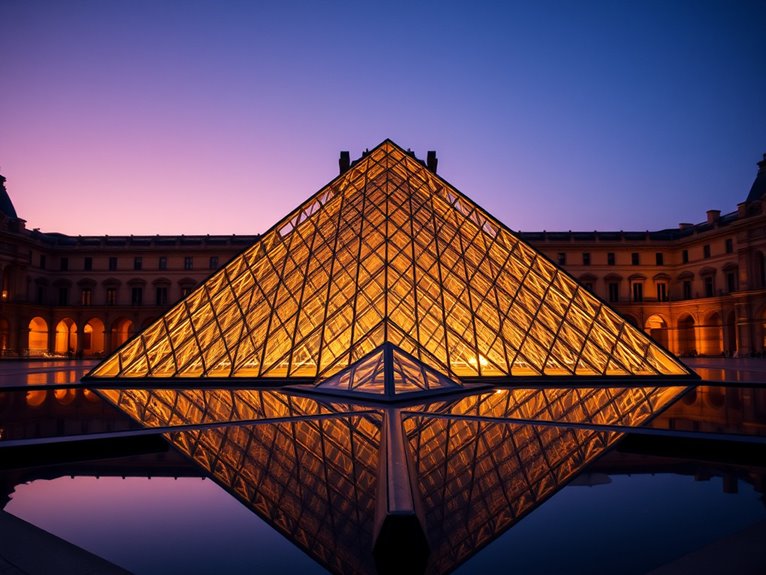
The world's largest art museum has played a starring role in numerous blockbuster films, enchanting audiences with its magnificent architecture and mysterious allure. From Tom Hanks racing through its corridors in The Da Vinci Code to Gal Gadot's Wonder Woman confronting villains beneath its iconic glass pyramid, the Louvre has become as much a character in modern cinema as it is a cultural institution.
This majestic palace-turned-museum offers filmmakers an unparalleled backdrop that combines historical grandeur with modern artistic vision. Its appearance in major films has not only boosted tourism but has also created a unique intersection between classical art and popular culture, making it one of Paris's most filmed locations.
Quick Facts:
- Best visiting hours: Wednesday and Friday evenings (open until 9:45 PM)
- Ticket prices: €17-25 (online booking recommended)
- Photography: Allowed without flash in most areas
- Film shooting permits: Required and must be arranged months in advance
- Quietest months: November through March
- Best entrance: Porte des Lions (lesser-known, shorter queues)
Featured Film Locations:
The Glass Pyramid (The Da Vinci Code)
Made famous by Dan Brown's novel and subsequent film, the controversial glass pyramid entrance now attracts thousands of Da Vinci Code enthusiasts. The pyramid, designed by I.M. Pei in 1989, appears in the film's pivotal final scene. Insider tip: Visit at dusk when the pyramid illuminates, creating the perfect photo opportunity without the daytime crowds.
Salle des États (Wonder Woman)
This grand gallery, home to the Mona Lisa, served as a key location in Wonder Woman 1984. While the film took creative liberties with the space, the actual room is equally impressive. Insider tip: Enter from the Sully Wing side to avoid the main crowd flow and get a better viewing angle of the famous painting.
Denon Wing Corridors (All Three Colors: Blue)
The long, ornate corridors of the Denon Wing featured prominently in Krzysztof Kieślowski's acclaimed film. These passages offer some of the museum's best architectural photography opportunities. Insider tip: The morning light through the windows creates stunning shadow patterns between 9-10 AM.
Pro Tips:
To capture film-worthy shots of your own, visit during the museum's extended evening hours on Wednesdays and Fridays. The combination of artificial and natural light creates a cinematic atmosphere, and the reduced crowds make it easier to recreate famous movie scenes. Consider using a wide-angle lens to capture the vast interior spaces, and bring a tripod for evening shots (though you'll need special permission to use it).
Practical Advice:
When planning a film-inspired visit to the Louvre, purchase tickets online and download the museum's mobile app, which includes themed tours including one highlighting famous movie locations. Remember that some areas featured in films may be temporarily closed for renovation or special exhibitions, so check the museum's website before visiting specific locations. Photography is generally allowed, but tripods and selfie sticks require special permission.
Montmartre Steps: An Amélie Walking Tour
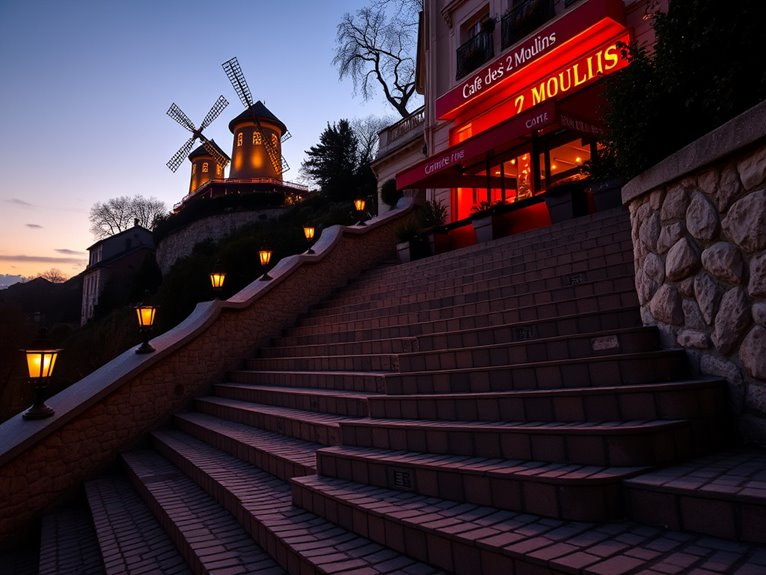
Following in the footsteps of the whimsical Amélie Poulain through the charming streets of Montmartre has become a beloved pilgrimage for film enthusiasts and romantics alike. The 2001 film "Amélie" transformed this historic Parisian neighborhood into a magical domain of possibility, where everyday locations became imbued with extraordinary significance through director Jean-Pierre Jeunet's distinctive lens.
This walking tour takes visitors through the most significant locations from the film, centered around the iconic steps of Montmartre. From the Café des 2 Moulins where Amélie worked to the grocery store where she helped a blind man cross the street, each stop offers both cinematic nostalgia and authentic Parisian charm that continues to captivate visitors two decades after the film's release.
Quick Facts:
- Best Visiting Hours: Early morning (8-10 AM) or late afternoon (4-6 PM)
- Walking Distance: Approximately 2.5 km
- Duration: 2-3 hours at a leisurely pace
- Cost: Free (excluding café purchases)
- Photography: Golden hour lighting best for steps (1 hour before sunset)
- Terrain: Steep inclines and numerous stairs
- Metro Stations: Abbesses (Line 12) or Blanche (Line 2)
Key Locations:
Café des 2 Moulins (15 Rue Lepic)
The famous café where Amélie worked remains a functioning establishment, serving traditional French cuisine. Still decorated with movie memorabilia, it operates daily from 7:30 AM to 11:30 PM. Insider tip: The bathroom featured in the film is actually a storage room now, but staff will sometimes let fans peek inside if asked politely.
Rue des Trois Frères Steps
These lesser-known steps where Amélie helps a blind man while describing the street scene offer a quieter alternative to the main Montmartre stairs. Located between numbers 51 and 53, they provide excellent photo opportunities without the crowds. Insider tip: Visit early morning when local artists are setting up their easels for the day's work.
Maison Collignon (56 Rue des Trois Frères)
The grocery store where Amélie plays matchmaker remains a working shop, though under different management. While smaller than it appears in the film, it maintains its charming exterior. Insider tip: The current owner keeps a photo album of the filming process that they'll share with interested visitors.
Pro Tips:
To truly capture the film's magical atmosphere, time your visit for early morning or just before sunset when the light creates the same golden glow seen in the movie. Avoid weekends when possible, as the main Montmartre steps become overwhelmed with tourists. Consider visiting during light rain – the wet cobblestones and moody atmosphere perfectly match the film's aesthetic, and crowds thin considerably.
Practical Advice:
Wear comfortable walking shoes with good grip – Montmartre's steep hills and cobblestone streets can be challenging. Bring a paper map as narrow streets can confuse GPS signals, and download relevant scenes from the movie beforehand to compare locations in real-time. Several cafés along the route offer perfect rest stops, but be aware that many small businesses in the area only accept cash or European credit cards.
Café Des Deux Moulins: Where Amélie Served Coffee
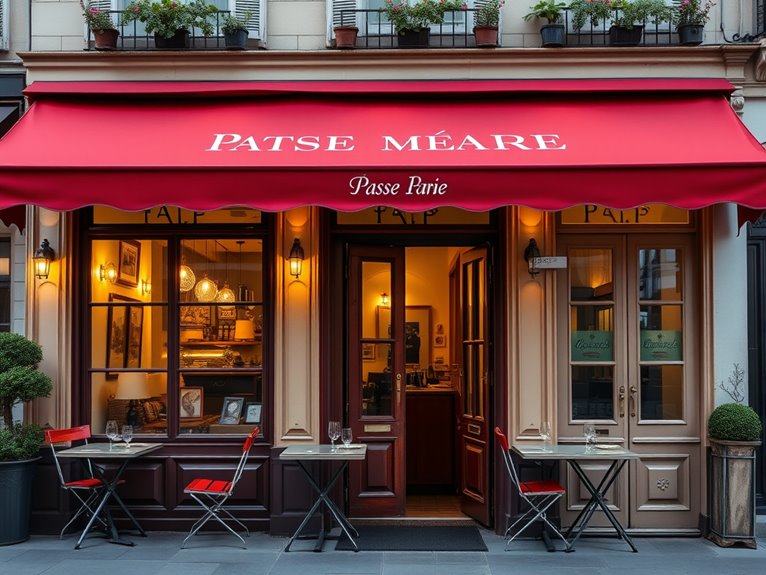
Iconic Movie Locations in Paris: Café Des Deux Moulins
Where Amélie Served Coffee
The charming Café des Deux Moulins, nestled in the heart of Montmartre, gained worldwide fame as the workplace of the whimsical Amélie Poulain in Jean-Pierre Jeunet's 2001 film "Amélie." This authentic Parisian café has transformed from a local neighborhood haunt into a must-visit destination for film enthusiasts and francophiles alike, while maintaining its genuine character as a working café frequented by locals.
Beyond its silver screen fame, the café offers visitors a chance to step into the magical world of Amélie while experiencing authentic Parisian café culture. The interior retains many elements featured in the film, including the iconic tobacco counter and the vintage décor that captured the imagination of millions of viewers worldwide.
Quick Facts:
- Opening Hours: Daily 7:00 AM – 11:00 PM
- Price Range: €3-20 (coffee to full meals)
- Best Time to Visit: Weekday mornings for fewer tourists
- Photography: Allowed inside, best lighting mid-morning
- Reservations: Not required but recommended for dinner
- Languages: French menu with English translations available
- Payment Methods: Cash and major credit cards accepted
The Café Experience:
The cafe sits at 15 Rue Lepic in the 18th arrondissement, easily accessible from the Blanche or Abbesses metro stations. While the famous crème brûlée featured in the film remains on the menu, the establishment offers a full range of traditional French café fare, from croissants to classic bistro dishes. The original Art Deco features and red awning make it instantly recognizable to fans of the film, while the warm atmosphere welcomes all visitors, whether movie buffs or not.
Insider Tip: Visit between 3:00 PM and 5:00 PM on weekdays to find the perfect balance between authentic ambiance and photo opportunities. The staff keeps a special guest book behind the counter – ask politely, and they might let you add your message to its movie-inspired pages.
Pro Tips:
To fully appreciate the Amélie experience, combine your café visit with a self-guided tour of other film locations in Montmartre. Start at the café, then walk to nearby spots like the Lamarck-Caulaincourt steps and the Sacré-Cœur, where other memorable scenes were filmed. For the best photos, position yourself at the corner table by the window, where Amélie's character often sat – but be prepared to wait during peak hours.
Practical Advice:
While the café embraces its film heritage, it's important to remember it's a functioning establishment serving local customers. Order at least a drink if you're taking photos, and be respectful of other diners. Consider visiting during shoulder seasons (spring or fall) when tourist crowds are thinner, allowing for a more authentic experience that bridges the gap between movie magic and real Parisian café culture.
Arc De Triomphe: Action Scenes Through the Decades
Standing proudly at the western end of the Champs-Élysées, the Arc de Triomphe has served as more than just a historical monument – it's become a coveted backdrop for some of cinema's most thrilling action sequences. From classic car chases in 1960s films to modern-day blockbusters, this 164-foot tall architectural marvel has played a starring role in countless memorable movie moments.
The monument's unique position at the center of Place Charles de Gaulle, where twelve grand avenues converge, has made it particularly attractive to filmmakers seeking dramatic pursuit scenes and spectacular aerial shots. Its imposing presence and the surrounding circular traffic pattern create natural tension and movement that directors have expertly utilized to enhance their storytelling.
Quick Facts:
- Best filming times: Dawn (6-8 AM) or dusk (8-10 PM) for ideal lighting
- Permit requirements: Commercial filming needs authorization from Paris City Hall
- Traffic patterns: Lightest between 10 PM-6 AM
- Photography zones: Best vantage points from Champs-Élysées and Avenue Kléber
- Observation deck hours: 10 AM-10:30 PM (April-September), 10 AM-9:30 PM (October-March)
- Filming restrictions: No drone photography without special permission
Notable Movie Appearances:
"Midnight in Paris" (2011)
The Woody Allen romantic comedy uses the Arc as a dreamy shift point between present and past Paris. Filmed primarily at night, the monument's illuminated facade creates an ethereal gateway effect. The production team utilized specialized lighting techniques to capture the monument's golden glow without overwhelming the scene's intimate atmosphere.
"Mission: Impossible – Fallout" (2018)
Tom Cruise's motorcycle chase scene circling the Arc became an instant classic. Filmed during early morning hours to minimize traffic disruption, the sequence required special permission from city authorities and careful coordination with local police. Insider tip: The production team used the underground tunnel to stage equipment and crew.
"The Bourne Identity" (2002)
The famous car chase sequence featuring Matt Damon maneuvering around the Arc showcases the monument's unique traffic pattern. Filmed over three nights using multiple camera angles, including rarely-granted rooftop positions. Little-known fact: The production team had to digitally remove modern traffic signs to maintain the scene's tension.
Pro Tips:
For photographers and film enthusiasts seeking to capture their own Arc de Triomphe shots, timing is essential. The golden hour (one hour before sunset) provides ideal natural lighting while minimizing harsh shadows. Additionally, visiting during winter months often yields clearer atmospheric conditions for cinematographic purposes. Consider the underground passage to access the monument – it's not only safer but offers unique low-angle shooting opportunities that many visitors overlook.
Practical Advice:
When planning any film-related visit to the Arc de Triomphe, remember that commercial photography requires permits obtained at least 15 days in advance. For personal photography, tripods are allowed on the observation deck but not on the surrounding sidewalks without permission. Always respect the eternal flame and guard ceremonies at the Tomb of the Unknown Soldier, which take priority over any filming activities. The nearby Publicis Drugstore offers excellent elevated views for establishing shots without the need for special access.
Pont Des Arts: Romance on the Love Lock Bridge
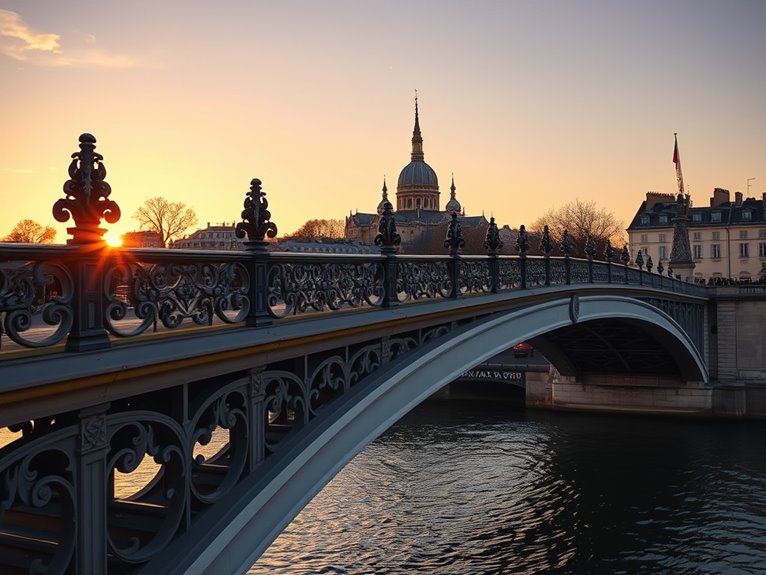
Iconic Movie Locations in Paris: Pont Des Arts
The Love Lock Bridge
The Pont des Arts, spanning the Seine River between the Louvre Museum and the Institut de France, has become one of Paris's most romantic landmarks and a favorite shooting location for filmmakers worldwide. This pedestrian bridge, originally built in 1804, has captured imaginations through its appearances in numerous romantic films, including "Amélie," "Midnight in Paris," and "Now You See Me."
Made famous by the tradition of couples attaching locks to its railings as symbols of eternal love, the bridge transformed into a global phenomenon, though the practice has since been discontinued to preserve the structure's integrity. Today, the Pont des Arts continues to draw visitors seeking to recreate iconic movie scenes or simply absorb the magical atmosphere that has made it a cinematic staple.
Quick Facts:
- Best visiting hours: Sunrise to sunset (most atmospheric at golden hour)
- Peak tourist times: 11 AM – 4 PM daily
- Photography conditions: Best during early morning or sunset
- Access: Free
- Nearest Metro: Pont Neuf (Line 7) or Louvre-Rivoli (Line 1)
- Current policy: Love locks are prohibited with €68 fine
- Bridge length: 155 meters (509 feet)
Cinematic History:
The bridge's most memorable appearance came in Woody Allen's "Midnight in Paris" (2011), where Owen Wilson's character takes his midnight walks across the structure. The scene perfectly captures the bridge's romantic atmosphere and twinkling lights reflecting off the Seine. Film enthusiasts can easily recreate these moments, particularly during the blue hour when the lighting matches the movie's magical ambiance.
Modern Experience:
While the love locks have been removed, the bridge now features art installations and transparent panels that offer unobstructed views of the Seine. Street musicians frequently perform here, creating an authentic Parisian atmosphere that rivals any movie scene. Insider tip: Visit during the first Sunday of each month when nearby museums are free, combining your bridge visit with cultural explorations.
Pro Tips:
For the best photo opportunities, arrive just before sunrise when the bridge is nearly empty and the light is soft and golden. Position yourself at the bridge's center point facing west for the perfect composition of the Seine, Eiffel Tower, and Pont Neuf in the background. During summer evenings, local artists often set up easels along the bridge, offering a chance to purchase unique Parisian artwork or watch them create.
Practical Advice:
Remember that the Pont des Arts is fully exposed to weather elements, so dress accordingly and bring protection from sun or rain. The wooden planks can be slippery when wet, and the bridge can get crowded during peak tourist hours. Consider visiting during shoulder seasons (March-April or September-October) for a more peaceful experience that better matches the romantic atmosphere portrayed in films.
Luxembourg Gardens: A Midnight in Paris Journey
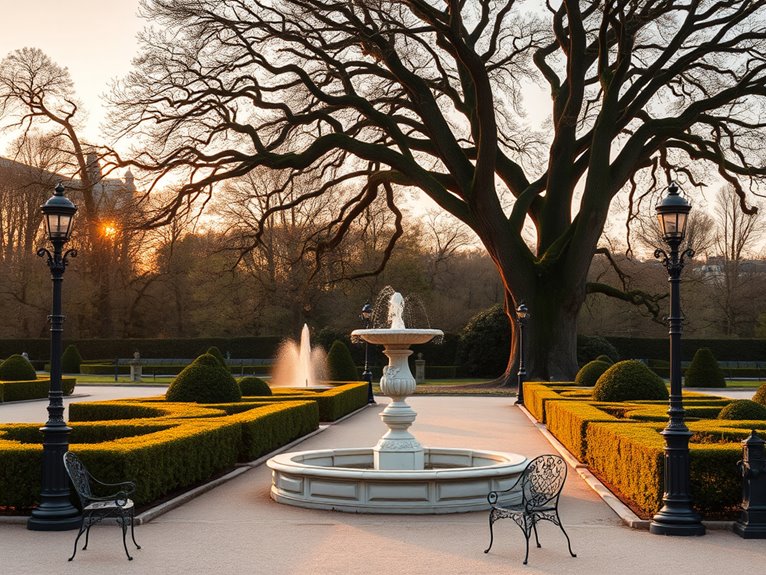
The Luxembourg Gardens (Jardin du Luxembourg) gained renewed fame through Woody Allen's nostalgic masterpiece "Midnight in Paris," where Owen Wilson's character Gil takes contemplative walks through its majestic grounds. This historic garden, created in 1612 by Marie de' Medici, serves as a pivotal location that links the film's present-day scenes with its magical time-traveling sequences.
Beyond its cinematic appeal, the Luxembourg Gardens represents Paris's soul, where art, history, and daily Parisian life converge. The garden's appearance in "Midnight in Paris" perfectly captures its timeless quality, showing how this verdant paradise has remained fundamentally unchanged for centuries, making it an ideal spot for film enthusiasts and culture seekers to experience their own magical moments.
Quick Facts:
- Opening Hours: 7:30 AM to sunset (varies seasonally)
- Admission: Free
- Best Photography Times: Early morning or golden hour (2 hours before sunset)
- Peak Crowds: Weekends 2-5 PM
- Film Scene Locations: Main fountain, tree-lined pathways, eastern terraces
- Photography Rules: Permitted for personal use; commercial shoots require permits
- Nearest Metro: Luxembourg (RER B)
The Medici Fountain
This iconic fountain, featured prominently in the film's connecting scenes, stands as one of the garden's most photographed locations. Built in 1630, it provides a perfect backdrop for recreation of Gil's contemplative moments. Located in the garden's eastern section, the fountain is best visited early morning when the light creates mystical reflections on the water.
Insider Tip: Visit during light rain – the fountain area becomes nearly empty, and the water creates a magical mist effect similar to the film's atmosphere.
The Grand Bassin
The central pond where Parisians sail toy boats appears briefly but memorably in the film. This octagonal basin offers one of the garden's most quintessentially Parisian experiences. Boat rentals are available Wednesday through Sunday (€3.50 for 30 minutes).
Insider Tip: The light hitting the water between 4-5 PM creates perfect photo opportunities, especially with the Luxembourg Palace as backdrop.
The Tree-Lined Allées
The garden's famous tree-lined walkways, where Gil begins his time-traveling adventures, offer the most authentic "Midnight in Paris" experience. These paths are particularly magical in autumn when golden leaves carpet the ground.
Insider Tip: The lesser-known western allées provide equally beautiful views but with fewer tourists.
Pro Tips:
To truly capture the film's magical atmosphere, visit during the "blue hour" – that brief period just after sunset when the sky takes on deep blue hues and the garden lamps create a golden glow. This timing perfectly recreates the movie's connecting scenes. Additionally, rainy days offer a unique opportunity to capture the garden's romantic atmosphere with fewer visitors, much like the film's moody sequences.
Practical Advice:
While the gardens close at sunset, positioning yourself near the eastern exit about 30 minutes before closing time allows for beautiful twilight photos of the adjacent streets that also appeared in the film. Bring a small foldable chair or blanket, as the famous green metal chairs are sometimes removed during off-hours or maintenance. Remember that while the gardens are free, certain areas like the Orangerie may have restricted access during special events or exhibitions.
The Eiffel Tower: Hollywood's Favorite Parisian Icon
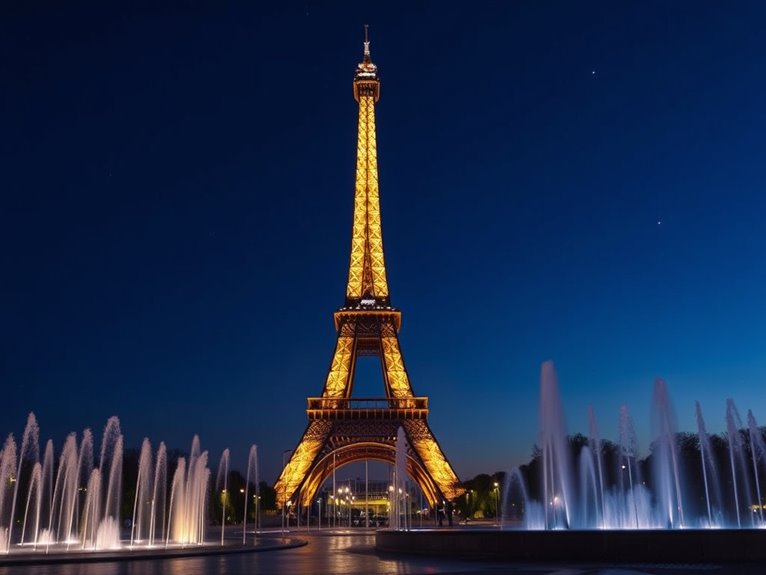
The Eiffel Tower has become synonymous with cinematic romance, action, and drama, serving as the most recognizable symbol of Paris in countless Hollywood productions. From romantic classics like "Midnight in Paris" to action-packed blockbusters such as "Mission: Impossible – Fallout," this architectural marvel has played both backdrop and character in films that have shaped global perceptions of the City of Light.
Beyond its status as a structural masterpiece, the Eiffel Tower's presence in movies has created a unique intersection of reality and fantasy, drawing millions of film enthusiasts yearly who seek to recreate their favorite movie moments. This guide explores the most iconic film locations featuring the Tower, how to capture the ideal shot, and insider knowledge for experiencing this landmark through a cinematic lens.
Quick Facts:
- Best Filming Times: Dawn (6-8 AM) or Dusk (8-10 PM)
- Photography Permits: Required for commercial filming
- Lighting Schedule: Tower sparkles for 5 minutes every hour after sunset
- Best Viewing Points: Trocadéro, Champ de Mars, Avenue de Camoëns
- Peak Tourist Hours: 11 AM – 5 PM
- Film Scene Access: Some movie locations require special permission
Notable Movie Locations:
The Trocadéro Platform: Made famous in countless films, this elevated plaza offers the most photographed view of the Tower. Located in the 16th arrondissement, it's accessible via metro stations Trocadéro or Passy. Arrive before 7 AM to recreate scenes without crowds. Insider tip: The stairs leading down from the platform provide unique angles rarely shown in tourist guides.
Champ de Mars: This sprawling green space, featured in "Midnight in Paris" and "Superman II," provides the classic picnic-with-Tower-view shot. Open 24/7, it's particularly magical at sunset. The lesser-known northeast corner offers unobstructed views without the typical tourist crowds.
Rue de l'Université: Featured in "Inception," this narrow street provides a dramatic ground-up view of the Tower. Located in the 7th arrondissement, it's best photographed between 2-4 PM when sunlight creates perfect lighting conditions. Secret tip: Number 15 offers the exact angle used in the film.
Pro Tips:
The best time for filming Tower-focused scenes is during the "blue hour" – approximately 30 minutes after sunset when the sky maintains a deep blue hue and the Tower's lights begin to shine. For unobstructed shots, visit during winter months when tourist numbers are lower and the bare trees provide clearer views. Consider using a wide-angle lens for architectural shots and a telephoto lens for detailed ironwork captures.
Practical Advice:
When planning movie-inspired photography sessions, obtain necessary permits well in advance, especially for commercial shoots. Be aware that using artificial lighting or professional equipment may require additional permissions. Many locations featured in famous films are on private property or require special access – research and secure permissions beforehand to avoid disappointment. Consider hiring a local film location guide for access to lesser-known vantage points and insider knowledge of shooting schedules.
